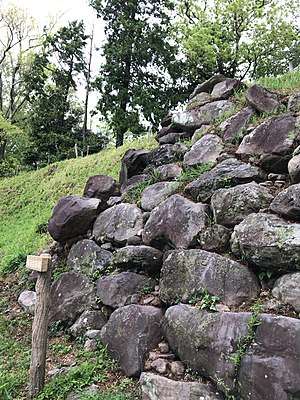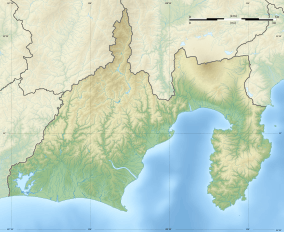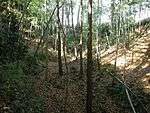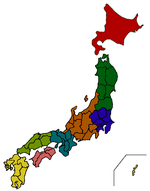Kōkokuji Castle
Kōkukuji Castle (興国寺城, Kōkukuji-jō) was a Sengoku period yamashiro-style Japanese castle located in what is now part of the city of Numazu, Shizuoka prefecture.[1] The site has been protected by the central government as a National Historic Site since 1975.[2]
| Kōkukuji Castle | |
|---|---|
興国寺城 | |
| Numazu, Shizuoka, Japan | |
 Stone wall of Kōkokuji Castle | |
 Kōkukuji Castle  Kōkukuji Castle | |
| Coordinates | 35°8′29.22″N 138°48′25.35″E |
| Type | hirayama-style Japanese castle |
| Site information | |
| Controlled by | Imagawa clan, Later Hōjō clan, Takeda clan, Tokugawa clan |
| Condition | vuins |
| Site history | |
| Built | 15th century |
| Demolished | 1607 |
Overview
Kōkukuji Castle is located on a ridge in the Ashitaka Mountains southwest of the center of modern Numazu city center. It consists of several kuruwa terraces protected by stone walls and a deep dry moat.
History
Kōkukuji Castle was originally built by the Imagawa clan to protect the eastern border of Suruga Province in the 15th century. Around 1487, it came under the control of Hōjō Sōun, founder of the late Hōjō clan. Hōjō Sōun's sister, Kitagawa-dono was married to Imagawa Yoshitada, and Hōjō Sōun became a retainer of the Imagawa clan. Yoshitada fell in battle in 1476 and as his son Imagawa Ujichika was still a minor, Ojika Norimitsu was appointed regent. However, Norimitsu later refused to turn over power as agreed, so Hōjō Sōun and his henchmen had him killed in order for the succession to go to his nephew Imagawa Ujichika. In return, Ujichika appointed Hōjō Sōun castellan of Kōkuku Castle. [3] But he moved his main castle to Nirayama Castle.[4]
In 1491, Hōjō Sōun intervened in the conflict between the Ashikaga shogunate and the Ashikaga of the Horigoe Gosho and seized control of Izu Province. He then relocated to Niirayama Castle in central Izu, returning Kōkuku Castle back to the Imagawa. The castle later changed hands between the Takeda clan and the Tokugawa clan after the fall of the Imagawa. After the Battle of Sekigahara, Tokugawa Ieyasu assigned the castle to Amano Yasukage, one of his old retainers. Amano was later disposed after an uprising in his territory and the castle was abolished in 1607.[5]
Kōkokuji Castle is now only ruins with some stone wall, earthen wallsand dry moat. The castle was listed as one of the Continued Top 100 Japanese Castles in 2017.[6]
Gallery
 Tenshu
Tenshu Honmaru compound from Tenshu
Honmaru compound from Tenshu Earthen wall
Earthen wall Large dry moat
Large dry moat Large dry moat2
Large dry moat2
References
- "興国寺城" (in Japanese). 沼津市観光ガイド. Retrieved 25 July 2019.
- "興国寺城跡". Cultural Heritage Online (in Japanese). Agency for Cultural Affairs. Retrieved 25 September 2018.
- "興国寺城跡" (in Japanese). Numaza city official. Retrieved 25 July 2019.
- "韮山城" (in Japanese). 伊豆の国市. Retrieved 25 July 2019.
- "興国寺城跡" (in Japanese). 攻城団. Retrieved 25 July 2019.
- "続日本100名城" (in Japanese). 日本城郭協会. Retrieved 25 July 2019.
- Motoo, Hinago (1986). Japanese Castles. Tokyo: Kodansha. p. 200 pages. ISBN 0-87011-766-1.
